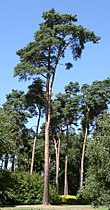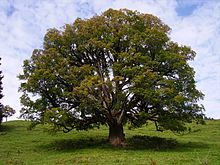Seed plant
| Seed plants Temporal range:
| |
|---|---|

| |
| Scots pine, Pinophyta
| |

| |
| Sycamore maple, Acer pseudoplatanus, a member of the Eudicots | |
| Scientific classification | |
| Kingdom: | Plantae |
| Clade: | Tracheophytes |
| Clade: | Spermatophytes |
| Extant divisions | |
| |
| Synonyms | |
| |
A seed plant or spermatophyte (lit. 'seed plant'; from
The term phanerogam or phanerogamae is derived from the
(gaméō), meaning "to marry". These terms distinguish those plants with hidden sexual organs (cryptogamae) from those with visible ones (phanerogamae).Description
The extant spermatophytes form five divisions, the first four of which are classified as gymnosperms, plants that have unenclosed, "naked seeds":[1]: 172
- Cycadophyta, the cycads, a subtropical and tropical group of plants,
- Ginkgophyta, which includes a single living species of tree in the genus Ginkgo,
- Pinophyta, the conifers, which are cone-bearingtrees and shrubs, and
- Ephedra, Gnetum, and Welwitschia.
The fifth extant division is the flowering plants, also known as angiosperms or magnoliophytes, the largest and most diverse group of spermatophytes:
- Angiosperms, the flowering plants, possess seeds enclosed in a fruit, unlike gymnosperms.
In addition to the five living taxa listed above, the fossil record contains evidence of many
- Pteridospermae, the so-called "seed ferns", were one of the earliest successful groups of land plants, and forests dominated by seed ferns were prevalent in the late Paleozoic.
- Glossopteris was the most prominent tree genus in the ancient southern supercontinent of Gondwana during the Permian period.
By the
Evolutionary history

A whole genome duplication event in the ancestor of seed plants occurred about 319 million years ago.[2] This gave rise to a series of evolutionary changes that resulted in the origin of modern seed plants.
A middle
Runcaria was followed shortly after by plants with a more condensed cupule, such as Spermasporites and Moresnetia. Seed-bearing plants had diversified substantially by the Famennian, the last stage of the Devonian. Examples include Elkinsia, Xenotheca, Archaeosperma, "Hydrasperma", Aglosperma, and Warsteinia. Some of these Devonian seeds are now classified within the order Lyginopteridales.[4]
Phylogeny
Seed-bearing plants are a
Internal phylogeny
The spermatophytes were traditionally divided into
| Spermatophytes |
| ||||||
However, the relationships between these groups should not be considered settled.[6][13]
Other classifications
Other classifications group all the seed plants in a single
- Division Spermatophyta
- Cycadopsida, the cycads
- Ginkgoopsida, the ginkgo
- Pinopsida, the conifers, ("Coniferopsida")
- Gnetopsida, the gnetophytes
- Magnoliopsida, the flowering plants, or Angiospermopsida
A more modern classification ranks these groups as separate divisions (sometimes under the Superdivision Spermatophyta):[citation needed]
- Cycadophyta, the cycads
- Ginkgophyta, the ginkgo
- Pinophyta, the conifers
- Gnetophyta, the gnetophytes
- Magnoliophyta, the flowering plants
Unassigned extinct spermatophyte orders, some of which qualify as "seed ferns":[citation needed]
- †Cordaitales
- †Calamopityales
- †Callistophytales
- †Caytoniales
- †Gigantopteridales
- †Glossopteridales
- †Lyginopteridales
- †Medullosales
- †Peltaspermales
- †Umkomasiales(corystosperms)
- †Czekanowskiales
- †Bennettitales
- †Erdtmanithecales
- †Pentoxylales
- †Petriellales Taylor et al. 1994
- †Avatiaceae Anderson & Anderson 2003
- †Axelrodiopsida Anderson & Anderson
- †Alexiales Anderson & Anderson 2003
- †Hamshawviales Anderson & Anderson 2003
- †Hexapterospermales Doweld 2001
- †Hlatimbiales Anderson & Anderson 2003
- †Matatiellales Anderson & Anderson 2003
- †Arberiopsida Doweld 2001
- †Iraniales E. Taylor et al. 2008
- †Vojnovskyales E. Taylor et al. 2008
- †Hermanophytales E. Taylor et al. 2008
- †Dirhopalostachyaceae E. Taylor et al. 2008
References
- ISBN 0-87893-403-0.
- .
- from the original on February 24, 2011. Retrieved March 22, 2011.
- ^ Anderson, John M.; Anderson, Heidi M.; Cleal, Chris J. (2007). "Brief history of the gymnosperms: classification, biodiversity, phytogeography and ecology" (PDF). Strelitzia. 20: 1–280.
- ^ PMID 17383970.)
{{cite journal}}: CS1 maint: multiple names: authors list (link - ^ PMID 21652302.
- S2CID 86302668.
- S2CID 91488394.
- PMID 15229124.
- PMID 10760277.
- PMID 10760278.
- PMID 21665594.
- PMID 16969937.
Further reading
- Thomas N. Taylor, Edith L. Taylor, and Michael Krings. 2008. Paleobotany: The Biology and Evolution of Fossil Plants, 2nd edition. Academic Press (an imprint of Elsevier): Burlington, MA; New York, NY; San Diego, CA, USA, London, UK. 1252 pages. ISBN 978-0-12-373972-8.





